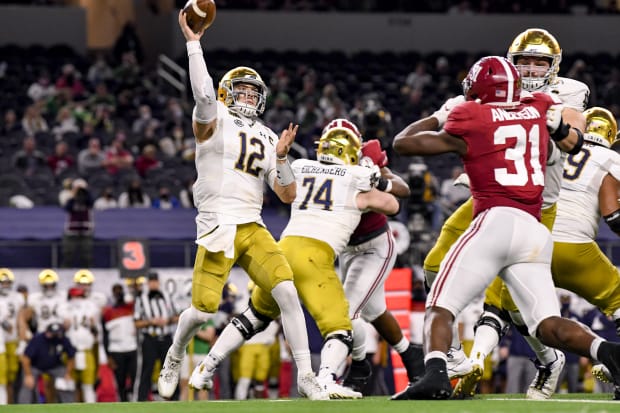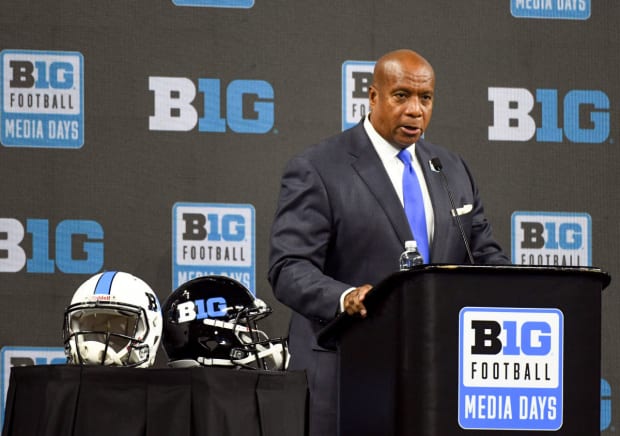For years, summer has been known as Talking Season in college football—the July conference media days produce a river of rhetoric from coaches and administrators that prime the pump for the blocking and tackling to come. But the past two summers have become Plundering Season as well, with the Southeastern Conference and Big Ten making blockbuster expansions at the expense of the Big 12 and Pac-12. That has, in turn, affected the nature of Talking Season.
Lately, the speeches from conference commissioners have been more anticipated, scrutinized and second-guessed than anything the coaches have to say. With revenue at an all-time high and collegiality at an all-time low, the boardroom drama is more fascinating than the actual games. The direction of the entire college athletics enterprise hangs in the balance, which is of greater gravitas than which teams had the best offseason in the weight room.
We’ve now reached a lull—dare to dream, maybe even a cessation—in realignment. We’ve heard from every conference commissioner as they assess the landscape. We saw flexing from Greg Sankey of the SEC and Kevin Warren of the Big Ten. We heard brass-tacks business talk from new Big 12 commissioner Brett Yormark. We got a dose of pushback and perspective— wistful and weak to some critics—from ACC boss Jim Phillips. And we got a mixture of dismay and defiance from the Pac-12’s George Kliavkoff.
With Talking Season over and Poaching Season on pause, where do we stand in college sports? Where has realignment taken us, and where could it be heading in the future? Our writer roundtable tackles six issues.

What is the Power 5 power ranking, and who ranks as the Best of the Rest?
At the moment—and we don’t know how long the moment will last—I’d rank them thusly.
1. SEC. The Big Ten may squeeze a little more revenue out of its media-rights deals, but the SEC is both rich and winning all the football championships. Right now, there is no comparison on the field. And the schools the SEC is adding (Texas and Oklahoma) carry a little more weight than what the Big Ten is adding (USC and UCLA).
2. Big Ten. In the new Power 2 landscape, the first coast-to-coast league is positioned to continue to distance itself from everyone but the SEC. It’s a long way back to third.
3. ACC. The conference is, paradoxically, held together and strained by its interminable media-rights contract through 2035–36. The prohibitive cost of breaking the league’s grant of rights agreement has undoubtedly kept some schools off the realignment market, but it also has created some angst in terms of the capped revenue. Will there be a push for uneven revenue distribution in the future? Phillips has his work cut out for him in terms of finding creative solutions.
4. Big 12. This could be a tie for fourth with the Pac-12, but ties are a cop-out. The Big 12 has already shown it can survive a poaching of its top programs by making some savvy additions for 2023 (BYU, Central Florida, Cincinnati, Houston). While the league doesn’t really have any A-listers, the B-list is lengthy and balanced—and not really upwardly mobile, providing a strange level of comfort. Yormark has shown some early flash; can he back it up with some strong moves to bolster the league’s standing?
5. Pac-12. Early indications are the conference can keep its current 10 members from splintering, although that solidarity might be only as strong as the Big Ten’s appetite for further expansion. The Pac-12 still has several major media markets and the late-night programming niche, which are good. But it doesn’t have much in the way of attractive expansion targets, and any further raiding of its membership could prove fatal.
6. Mountain West. With the American Athletic Conference set to lose three top schools next year, the path is clear for the MWC to move up the pecking order to Best of the Rest. San Diego State has a new stadium and is the only Southern California program that belongs to a Western conference; Boise State is a perennial contender, while several other programs have had 10-win seasons in recent years. —Pat Forde
Which schools hold the most power going forward? And which programs will decide what happens next?

Greg Nelson/Sports Illustrated
1. Notre Dame. The Fighting Irish are the lever that can send everything spinning—or strengthen the status quo. The stubbornly proud independent blueblood is the clear top target for the Big Ten, but the Irish are hopeful (even confident) they can reap enough revenue from their next media-rights deal with NBC to continue stiff-arming the conference that has coveted them for time immemorial. If Notre Dame goes to the Big Ten, then Stanford might follow as its preferred plus-one, and that could hasten the demise of the Pac-12. Everyone is keeping an eye on the Golden Dome.
2. Oregon and Washington. They will be the perceived leaders of the Pac-12 going forward, but they’d also likely jump to the Big Ten immediately if offered an opportunity. For the moment, Big Ten/Fox Sports appetite for the Pacific Northwest pair appears tepid, and there could be difficulties with the state legislature in terms of uncoupling from Oregon State and Washington State. What deal they might ask for from the Pac-12 in its new media-rights package—like a no-penalty out for the Big Ten—will say a lot about their true intentions.
3. Stanford. Its stand-alone athletic marketability is debatable—a disinterested fan base and dependence on Notre Dame illustrate the limitations. But the academic credentials and Silicon Valley ties dilate the pupils of university presidents. The Cardinal could be a wild card in all this.
4. The ACC’s top dogs. This could be a decade down the road, when the exit penalties lessen substantially, but a few schools from this league eventually could be ready to move. It’s believed the Big Ten and SEC could have interest in North Carolina, which is an appealing brand that commands an audience in a populous state not currently part of either league’s footprint. Virginia also has some allure. From a pure football standpoint, Clemson, Florida State and Miami have the most cache (dated as it might be for the Seminoles and Hurricanes).
5. San Diego State. If there is a Group of 5 school that could potentially fill a Power 5 need, the Aztecs and Pac-12 might have a marriage of convenience. Or not. —P.F.
Who has the most to lose in this realignment chaos?

1. Oregon State and Washington State. Absent from many realignment rumblings are the folks in Corvallis and Pullman. You don’t see any reports linking the Beavers and Cougars to the Big Ten, Big 12 or any other league. They are two of the lowest-resourced universities in the Power 5 who are located in tiny media markets and have very little historical success in football. OSU and WSU would likely tumble down to the Mountain West if the Pac-12 implodes.
2. The Group of 5. With every realignment wave, the Power 5 grows in size and, well, power. Oklahoma and Texas’s moves to the SEC set off a domino effect that resulted in UCF, Cincinnati, BYU and Houston moving to a Power 5 league. Their replacements in the G5? That would be FCS squads Jacksonville State and Sam Houston State, both of whom are joining Conference USA. The USC and UCLA shift to the Big Ten might trigger more such moves. The gaps between the haves (Power 5) and have-nots (Group of 5) continue to grow. Heck, the gap within the Power 5 is now a chasm. As one administrator recently surmised, “It’s become the Big 2 (SEC, Big Ten), Other 1 (ACC) and Group of 7.”
3. Fans and families of athletes. Conferences were originally created because of their location. They connected like-minded universities with similar finances that resided in the same cultural and geographic footprint. They also provided fans and families a fairly easy and affordable trip to watch their team/children compete on the road. Realignment has destroyed many regional rivalries, driveable road trips and, let’s be honest, just plain fun. USC is now in the same league as Rutgers. UCF will play in a conference whose headquarters (Dallas) is 1,100 miles away. And New Mexico State will be in the same league as Virginia-based Liberty. —Ross Dellenger
Which network has the upper hand, Fox or ESPN?

Robert Goddin/USA TODAY Sports
Moving forward, it is unquestionably Fox. While ESPN is the biggest chip on the board in the SEC (especially when it gets exclusivity in 2024), Fox is in prime position to wrestle some of the locus of control back from the four-letter network. Fox now has Los Angeles in its pocket, but also stands to gain a seat at the table if the College Football Playoff expands after this current TV deal expires. It’s clear the Pac-12 and Big Ten want multiple TV partners involved in negotiations instead of just ESPN, which means, in all likelihood, ESPN will somehow have to share the CFP with Fox. —Richard Johnson
What has been the best rumor of the past month?
Realignment is the silly season on steroids. Everyone covering college football eventually misses, and there is perhaps no time when people throw more stuff at the wall than when teams move leagues. I was on vacation during the thick of the USC/UCLA aftermath and somehow missed what was a truly outrageous day on Twitter, which included a rumor that Virginia, North Carolina, Florida State and Clemson would jump to the SEC. It came with an additional “scoop” that ESPN was trying to void a 20-year deal with ACC. —R.J.
Our best guess at what will be the next big move?
While realignment seems to be on pause at the moment, it is unlikely to stay that way. Does it mean the Big Ten will add two more teams tomorrow, or the Big 12 will poach half the Pac-12 by the end of next week? No, but the next three to five years are certain to bring more movement within the Power 5.
The Pac-12’s two remaining biggest brands, Washington or Oregon, are unlikely to sign any kind of long-term contract to remain in the league. Three years? Maybe. Six years? No way. If negotiations over the Pac-12’s new TV deal don’t go as planned, maybe we see the Ducks and Huskies move, especially if (1) the Big Ten drops an invite or (2) the Big 12’s TV negotiations in two years produce a more glamorous revenue figure.
Either way, the Big Ten seems willing to eventually expand again, and that means the SEC could respond with another expansion of its own, potentially reciprocating the interest from a bevy of ACC teams that could challenge the grant of rights in exchange for a spot in one of the Big 2. Buckle up. By 2028, the sport could be a 40-team, two-conference structure that perhaps operates as a semiprofessional entity. —R.D.
More College Football Coverage:







